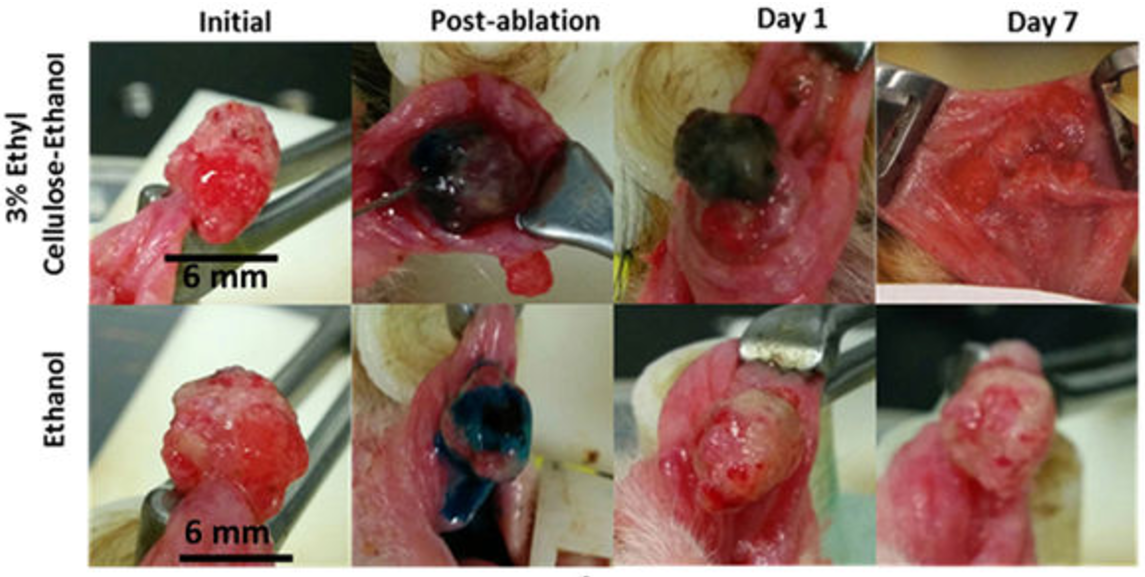In the rich world, cancer therapy is expensive. In the developing world, it may not be available at all. Not only is cutting-edge technology in short supply, but so are things like electricity and medical personnel. The lack of necessary resources for basic healthcare is made obvious by the fact that, if diagnosed with cancer, a person in the developing world is more likely to die from it than a person in the developed world.
To help alleviate this problem, cheap, uncomplicated, portable, and preferably non-surgical treatments that do not require electricity are needed. Now, a team of researchers from Duke University has shown that injecting an ethanol-based gel directly into a specific type of tumor, called squamous cell carcinoma, resulted in a 100% cure rate in a hamster model.
The authors were already aware of a therapy known as ethanol ablation. If ethanol (the type of alcohol found in your favorite adult beverages) is injected into a tumor, it destroys proteins and causes the cells to dehydrate and die. Ethanol ablation is used to treat one type of liver cancer, and its success rate is similar to that of surgery. Better yet, it costs less than $5 per treatment.
Ethanol ablation faces several limitations. First, it only works well for tumors that are surrounded by a fibrous capsule. Second, it requires large amounts of ethanol, which can damage nearby tissue as it leaks out. And third, it requires multiple treatments.
To overcome these hurdles, the authors mixed ethanol with ethyl cellulose, creating a solution that when injected into the watery environment of a tumor turns into a gel, which remains close to the injection site. After they practiced injecting their solution into imitation tumors (what they called "mechanical phantoms"), the authors turned to a hamster model.
The team induced the formation of oral cancer (specifically, squamous cell carcinoma) in hamster cheek pouches by rubbing them with a carcinogen called DMBA. After about 22 weeks, tumors (without capsules) formed.
 In the control group, tumors were injected with pure ethanol. The results were not good. After seven days, 0 of 5 tumors regressed completely. (Tumors injected with a large amount of ethanol -- four times the volume of the original tumor -- performed better: 4 of 12 regressed completely.) The results for the ethanol gel were far superior. After seven days, 6 of 7 tumors regressed completely. (By the eighth day, all 7 tumors were gone, for a cure rate of 100%.)
In the control group, tumors were injected with pure ethanol. The results were not good. After seven days, 0 of 5 tumors regressed completely. (Tumors injected with a large amount of ethanol -- four times the volume of the original tumor -- performed better: 4 of 12 regressed completely.) The results for the ethanol gel were far superior. After seven days, 6 of 7 tumors regressed completely. (By the eighth day, all 7 tumors were gone, for a cure rate of 100%.)
As merely a proof-of-concept in an animal model with small sample sizes, obviously more work needs to be done. Still, the results are incredibly promising. The team's findings suggest that merely a single injection of their special ethanol-based gel may be sufficient to cure certain types of tumors. They believe their technique may be applicable to some breast cancers and cervical precancerous lesions.
Furthermore, any technological advances that result from the team's research will have applicability not only to the developing world but to the developed one, as well.
Source: Robert Morhard, et al. "Development of enhanced ethanol ablation as an alternative to surgery in treatment of superficial solid tumors." Scientific Reports 7, Article number: 8750. Published: 18-Aug-2017. doi: 10.1038/s41598-017-09371-2


Feel free to write